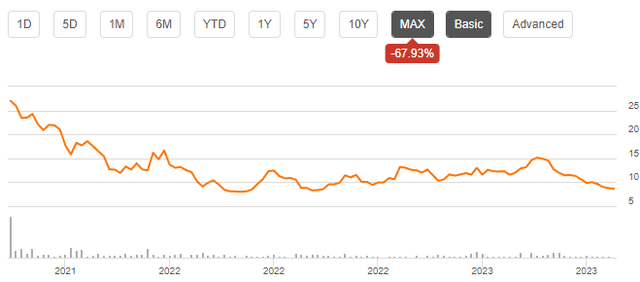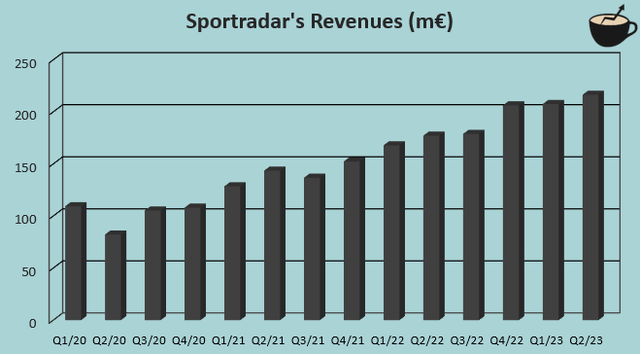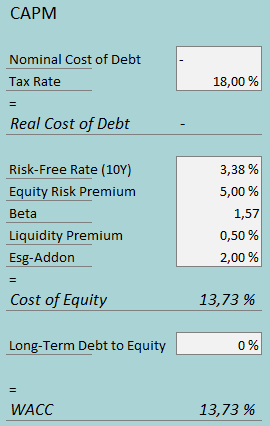Sportradar Group (NASDAQ:SRAD) has been able to grow the company’s revenues on a mostly consistent basis. I believe that the company has a good position in the industry due to the company’s extensive data sets in the sports industry. The company seems fundamentally quite good, but I believe that the investment case relies on significant margin expansion in the future as current margins don’t yield a good amount of cash flows even with significant growth. As Sportradar is on track to achieve a good amount of margin expansion in 2023 already, I believe that the company should be able to execute well. At the moment, I believe that a hold-rating is most sensible.
The Company & Stock
Sportradar provides data to sportsbooks and sports organizations. The company’s offerings revolve around data of sports teams, players, as well as fans’ behavior. Through the company’s extensive data sets, Sportradar should be able to differentiate itself from most competitors – the proprietary data enables Sportradar to create more accurate models, creating a significant competitive edge in the very competitive sportsbook odds market among other data use cases.
In my opinion, the company’s business can be divided into two main parts, Betting & Gaming and Sports Organizations & Sports Solutions. The Betting & Gaming part focuses on providing sportsbook sophisticated data. The company’s betting offering includes solutions such as data, odds, statistics, streaming, marketing, and management. On the other hand, the Sports Organizations & Sports Solutions parts focuses on other sports organizations, providing solutions to marketing, streaming, and content for sports fans.
Since Sportradar first began trading in September, the stock has lost around two thirds of its value:
Stock Chart From IPO (Seeking Alpha)
Financials
Sportradar has achieved a good amount of growth in the company’s recent past. From 2019 to 2022, the company’s revenues have grown at a compounded annual rate of 22.4%. On a quarterly basis, the growth has been quite stable:
Author’s Calculation Using TIKR Data
I believe that Sportradar still has a long growth road ahead. The gaming industry is experiencing a good amount of growth in geographics such as North America, Latin America, and parts of Asia for years to come. For the current year, Sportradar is guiding for revenues of €902 million to €920 million, representing a growth of 24% to 26%.
The company’s margins have fluctuated largely. As the company has doubled down on extensive investments on both R&D and marketing to fuel growth and a competitive advantage, Sportradar’s EBIT margin has fallen from a figure of 11.9% in 2020 to a figure of 6.0% in 2022. In 2023 so far, the company has reversed the deteriorating margin into a good amount of margin expansion. In H1 of 2023, the company’s EBIT margin was 8.1% compared to a H1/2022 margin of 4.1%. I believe that the company is nearing a critical point in scale in which Sportradar can scale its EBIT margin well despite extensive investments. The company has a gross margin of 40.7% with trailing numbers, providing a good amount of room for operating leverage as Sportradar’s revenues grow.
Valuation
I don’t believe that a P/E ratio represents Sportradar’s valuation well at the moment as the company should grow in a good pace along with scaling margins. A discounted cash flow model contextualizes the valuation a lot better, and provides an estimate for a fair value for the stock.
In my DCF model, I estimate Sportradar to hit its 2023 revenue guidance with a growth of 25%. After 2023, I estimate the growth to slow down in slow steps with a growth of 18% in 2024, a growth of 15% in 2025, and so on. The growth eventually slows down into a perpetual rate of 3%, above my usual estimate of 2% as the company should have a long roadmap of growth ahead. The estimated growth represents a CAGR of 11.1% from 2022 to 2032.
On the margin side, I estimate significant margin expansion for Sportradar. For 2023, I estimate an EBIT margin of 9.1% representing an expansion of 3.1 percentage points for the year. After 2023, I model in a lot of further operating leverage – I estimate the company’s EBIT margin to eventually rise into a level of 19.1%, over double of the margin that I estimate for the current year. I believe that Sportradar will have quite a good cash flow conversion, as the company’s investment pace should slow down at some point. The company also already has a significant amount of depreciation and amortization in the accounting earnings.
The mentioned estimates and a cost of capital of 13.73% craft the following DCF model with a fair value estimate of $8.48 around 4% below the price at the time of writing, representing a roughly fairly valued stock:
DCF Model (Author’s Calculation)
The used weighed average cost of capital is derived from a capital asset pricing model:
CAPM (Author’s Calculation)
Sportradar doesn’t currently hold a significant amount of long-term debt on the company’s balance sheet, and I wouldn’t expect the company to draw any in the foreseeable future as the company’s cash flows still vary largely due to extensive investments – I have a long-term debt-to-equity ratio estimate of 0%. The company does have a €220 million credit facility, but hasn’t used the facility so far, and continues to have a large cash balance for future investments.
Contrary to most of the companies that I’ve covered, Sportradar is incorporated in Switzerland instead of the United States and reports its figures in euros instead of dollars – the CAPM’s used figures on the cost of equity side vary from usual estimates. For the risk-free rate, I use the 10-year Euribor swap rate of 3.384%. The equity risk premium of 5.00% is Professor Aswath Damodaran’s latest estimate for Switzerland. Tikr estimates Sportradar’s beta at a figure of 1.57. In addition, I add a liquidity premium of 0.5% and an ESG-addon of 2% into the cost of equity, crafting the cost of equity and WACC at 13.73%.
Takeaway
Sportradar should have a great growth story ahead. The company operates on the gaming industry that should be experiencing a high amount of medium- and long-term growth in geographies such as North America, Latin America, and Asia. The investment case does rely on a good amount of margin expansion, though; investors should keep a close eye on the company’s margin trajectory going forward. As my DCF model estimates the stock to be very near its fair value, I have a hold-rating for the time being.
Read the full article here



